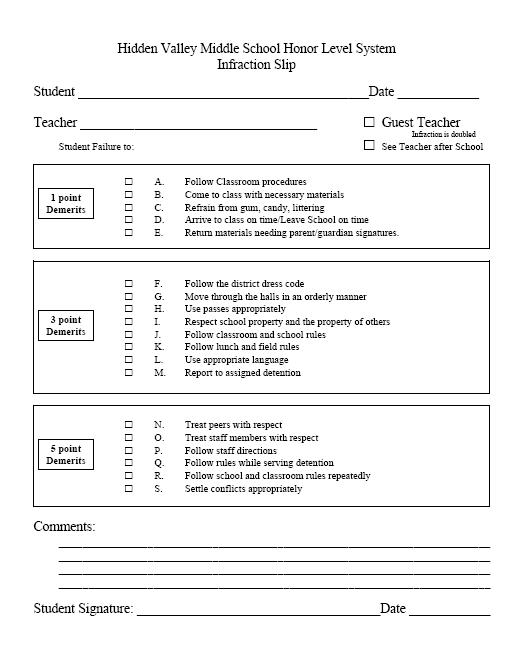Infractions
The core of any school-wide discipline plan is centered on a set of rules. We prefer to use the term Expectations instead. The difference is not important to the implementation of your program. It is more significant in the approach used to change student behavior. Click here if you want to read more about the Philosophy of Expectations vs. Rules. For the rest of this page, we will use the term: Expectations more often than Rules. No matter what your own philosophy may be, what follows is the same for whichever term you prefer.
The Infraction Slip
The infraction slip is what the staff uses to pass information on to whoever enters HLS data at the computer. Click here to find out how it can be also be used as a powerful tool as the second step in a Classroom Discipline Plan.
As a staff you determine what your behavioral expectations are. Some schools include students in this process and a lot of good things can be said for doing so. We encourage school to list their expectations in a positive form. For example, Move through the building in an orderly manner works better than: No running in the building. When we give a student an infraction for this item we are then citing him or her for Failure to: Move through the building in an orderly manner.
The next step is to organize your list of expectations and weight them. Most schools list their items beginning with the lesser ones and working to the more severe. As far as your HLS software is concerned, the order in which you list them is not important.
Please Note: The infraction slip is used for the ordinary discipline problems that we see often. "Big Ticket" offences such as fighting, vandalism, procession of dangerous or illegal items, etc., are handled in HLS by Administrative Assignments and you would probably use a more detailed referral form - perhaps the same as you have been using in the past.
This being said, a school can configure the program to assign a consequence when a student receives too many minor infractions. For example, you may allow a student two "freebies" within the Roll-Over Window but when she gets three or more, a consequence is then assigned. Click here if you want to know how to configure your software to watch for Multiple Minor Infractions.
Sample Infraction Slip ...

Weighting the Infractions
Infractions can be weighted from 0 to 9 demerits. The demerits are used to calculate the student's Honor Level.
Generally we recommend that you use the values of 1, 3, and 5 when weighting your infractions.
- 1 Demerit Infractions:
- Arrive to class on time
- Come to class with all necessary materials
- Bring a signature from home
These are generally organizational problems, not behavioral problems. They include expectations such as:
Your HLS program will give special consideration to these 1 demerit items. Click here to learn more about Non-Progressive Infractions and how to de-activate this feature if you so choose.
- 3 Demerit Infractions:
- Move through the building in an orderly manner
- Use a hall pass when required
- Leave toys and electronic devices at home
These are minor behavior problems that generally have to do with order and safety. They would be inappropriate things that kids do, but not things they do to someone else. They include expectations such as:
- 5 Demerit Infractions:
- Treat peers with respect
- Respect school property and the property of others
- Settle conflicts appropriately
These are minor behavior problems that generally have, for want of a better term, a victim. Now the student has done something to another. They include expectations such as:
Having different weighting for the same infraction.
Your staff may want to have a choice of how many demerits a student gets for some infractions. You can do this by putting the infraction in twice. You will need a different letter for each one.
Look at items J and R in the sample slip above. Hidden Valley Middle School has changed the wording a bit, but they can be stated exactly the same if you wish.
Infractions to Avoid:
Over the years we have found that some items that seem like good ideas, really don't work well at all. For some reason, teachers like to gravitate to the least specific infractions on your list. Here is a couple that you should avoid using:
- Contribute to a positive learning environment
- other
We have found that when these are choices on the infraction slip, they will be selected more often than all the others.
Teachers may be encouraged to select other and then add detailed comments thinking this is a good thing. However, not only does this make a lot more work for whoever enters the infractions at the computer, the powerful Data Analysis tools cannot provide you with the detailed results you would get if the teacher marked a specific item instead.
Setting up your infraction list:
Click here to see how to Create and Edit Infractions.